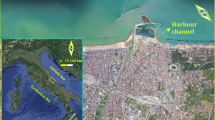Abstract
The aim of this study was to delineate the spatial zonation of the Curonian Lagoon based on the hydraulic regime and the sediment characteristics. A finite element hydrodynamic model has been applied to the Curonian Lagoon to simulate the circulation patterns for three years. With the help of a transport diffusion model the salinity distribution and the residence times of the Curonian Lagoon have been investigated when forced by river runoff and by wind. The finite element method permitted to follow the details of bathymetry and morphology of the lagoon, describing the areas of special interest with higher resolution. The hydrodynamic model has been validated using in situ water level and salinity measurements. A statistical GIS analysis of the bottom sediment characteristics and the modeled residence times and salinity distribution led to a synthetic hydraulic regime-based zonation scheme. The derived classification scheme is of crucial value for understanding the renewal capacity and biota distribution patterns in the lagoon.







Similar content being viewed by others
References
Červinskas, E., 1959. The Main Features of the Hydrological Regime, Curonian Lagoon Results of a Complex Investigation. Institute of Biology, Vilnius: 47–67 (in Russian).
Chubarenko, B. V. & I. P. Chubarenko, 1995. Modelling of currents in the Curonian Lagoon during storm wind influence. Meteorology and Hydrology 5: 54–60 (in Russian).
Cucco, A. & G. Umgiesser, 2006. Modeling the Venice Lagoon residence time. Ecological Modelling 193: 34–51.
Davulienė, L., I. Davulienė, S. Dick, G. Trinkūnas & L. Valkūnas, 2002. Validation of the circulation model for Lithuanian coastal waters. Journal of Environmental and Chemical Physics 24(4): 226–231.
Dumbrauskas, A., & P. Punys, 2003. Hydrological aspects of flooding of the Nemunas river delta. In EcoFloof International Conference, Towards Natural Flood Reduction Strategies, Warsaw.
Ferrarin, C. & G. Umgiesser, 2005. Hydrodynamic modeling of a coastal lagoon: the Cabras lagoon in Sardinia, Italy. Ecological Modeling 188: 340–357.
Gasiūnaitė, Z. R., 2000. Coupling of the limnetic and brackishwater plankton crustaceans in the Curonian lagoon (Baltic Sea). International Review of Hydrobiology 85: 649–657.
Gasiūnaitė, Z. R. & A. Razinkovas, 2002. The salinity tolerance of two cladoceran species from the Curonian lagoon: an experimental study. Sea and Environment 2(7): 28–32.
Gasiūnaitė, Z. R. & A. Razinkovas, 2004. Temporal and spatial patterns of the crustacean zooplankton dynamics in transitional lagoon ecosystem. Hydrobiologia 514: 139–149.
Gulbinskas, S., 1995. Distribution of recent bottom sediments in the depositional area Curonian Lagoon-Baltic Sea. The geographical Yearbook 28: 296–314 (in Lithuanian).
Pilkaitytė, R. & A. Razinkovas, 2006. Factors controlling phytoplankton blooms in a temperate estuary: nutrient limitation and physical forcing. Hydrobiologia 555(1): 41–48.
Pustelnikovas, O., 1998. Geochemistry of sediments of the Curonian Lagoon. Mosko Aidai, Vilnius: 234.
Raudsepp, U. & T. Kõuts, 2002. Wind-driven circulation in the Curonian Lagoon. Journal of Environmental and Chemical Physics 24: 151–155.
Rodhe, H., 1992. Modeling Biogeochemical Cycles. Academic Press: 55–71.
Scroccaro, I., A. Cappelletti, & G. Umgiesser, 2003. An idealized circulation for the Orbetello Lagoon. In Ozhan, E. (ed.), Proceedings of the Sixth International Conference on the Mediterranean Coastal Environment, Vol. 3, Ankara, Turkey: 2087–2098.
Takeoka, H., 1984a. Exchange and transport time scales in the Seto Inland Sea. Continental Shelf Research 3: 327–341.
Takeoka, H., 1984b. Fundamental concepts of exchange and transport time scales in a coastal sea. Continental Shelf Research 3: 311–326.
Umgiesser, G., 1997. Modeling the Venice Lagoon. International Journal of Salt Lake Research 6: 175–199.
Umgiesser, G. & A. Bergamasco, 1995. Outline of a primitive equations finite element model. Rapporto e Studi, Istituto Veneto of Scienze. Lettere ed Arti XII: 291–320.
Umgiesser, G., 2000. Modeling the residual current in the Venice Lagoon. In Yanagi, T. (ed.), Interaction Between Estuaries, Coastal Seas and Shelf Seas. Terra Scientific Publishing Company, Tokyo: 107–124.
Umgiesser, G., D. Melaku Canu, A. Cucco & C. Solidoro, 2004. A finite element model for the Venice Lagoon. Development, set up, calibration and validation. Journal of Marine Systems 51: 123–145.
Žaromskis, R., 1996. Okeani Juros Estūarijos. Geografijos Institutas, Vilnius, Lithuania (in Lithuanian).
Zemlys P., A. Ertürk & A. Razinkovas. 2D finite element ecological model for the Curonian lagoon. Hydrobiologia (in press).
Acknowledgments
The authors wish to thank the Marine Research Centre, Lithuanian Ministry of Environment, and Hydrometeorological Service, Lithuanian Ministry of Environment, for providing forcing and validation data.
Author information
Authors and Affiliations
Corresponding author
Additional information
Guest editors: A. Razinkovas, Z. R. Gasiūnaitė, J. M. Zaldivar & P. Viaroli
European Lagoons and their Watersheds: Function and Biodiversity
An erratum to this article can be found online at http://dx.doi.org/10.1007/s10750-010-0339-z.
Rights and permissions
About this article
Cite this article
Christian, F., Arturas, R., Saulius, G. et al. Hydraulic regime-based zonation scheme of the Curonian Lagoon. Hydrobiologia 611, 133–146 (2008). https://doi.org/10.1007/s10750-008-9454-5
Published:
Issue Date:
DOI: https://doi.org/10.1007/s10750-008-9454-5




